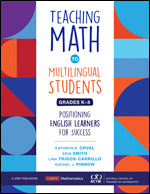Teaching Math to Multilingual Students, Grades K-8
Positioning English Learners for Success
- Kathryn B. Chval - University of Missouri, Columbia, MO, USA, University of Notre Dame, The University of Illinois at Chicago, USA
- Erin Smith - The University of Southern Mississippi, USA
- Lina Trigos-Carrillo - Universidad de La Sabana, Colombia
- Rachel J. Pinnow - University of Missouri, USA
Corwin Mathematics Series
It’s time to re-imagine what’s possible and celebrate the brilliance multilingual learners bring to today’s classrooms. Innovative teaching strategies can position these learners as leaders in mathematics. Yet, as the number of multilingual learners in North American schools grows, many teachers have not had opportunities to gain the competencies required to teach these learners effectively, especially in disciplines such as mathematics. Multilingual learners—historically called English Language Learners—are expected to interpret the meaning of problems, analyze, make conjectures, evaluate their progress, and discuss and understand their own approaches and the approaches of their peers in mathematics classrooms. Thus, language plays a vital role in mathematics learning, and demonstrating these competencies in a second (or third) language is a challenging endeavor.
Based on best practices and the authors’ years of research, this guide offers practical approaches that equip grades K-8 teachers to draw on the strengths of multilingual learners, partner with their families, and position these learners for success. Readers will find:
• A focus on multilingual students as leaders
• A strength-based approach that draws on students’ life experiences and cultural backgrounds
• An emphasis on maintaining high expectations for learners’ capacity for mastering rigorous content
• Strategies for representing concepts in different formats
• Stop and Think questions throughout and reflection questions at the end of each chapter
• Try It! Implementation activities, student work examples, and classroom transcripts
With case studies and activities that provide a solid foundation for teachers’ growth and exploration, this groundbreaking book will help teachers and teacher educators engage in meaningful, humanized mathematics instruction.
Kathryn Chval and her colleagues exquisitely give the readers opportunities to see inside a classroom with multilingual students, develop empathy, and deeply understand effective practice. The book’s engaging format provides questions for reflection and strategies to try out, connects research to practice, and compels readers to position students for success.
This is the book I’ve been waiting for! It is powerful. It brings together often-separate critical ideas for teaching multilingual students and weaves them with in-depth explorations of classrooms. We meet remarkable teachers, whose success we can learn from, which will help us reimagine what’s possible.
A must-read! This book is an excellent resource to closely examine mathematics instruction that affirms multilingual learners’ identities, competencies, and growth as learners of mathematics. Far too often multilingual children and their families are positioned in deficit ways that lead to limited learning. This book does the opposite. It seamlessly blends practice and research for a comprehensive look at exemplary mathematics teaching that leverages children’s multiple linguistic, cultural, and mathematical strengths. The book offers practical tools and guidance to enhance mathematics instruction, nurture student relationships, and create strong partnerships with families to support and advance multilingual learners in mathematics.
This book goes beyond the typical support of the academic language of mathematics for English learners. It provides an in-depth perspective on being more culturally inclusive of English learners and allows educators to reflect on their instructional methodologies in mathematics.
This book celebrates the brilliance of multilingual learners while also providing evidence-based strategies for teachers. The included cases and activities provide a solid foundation for teachers’ growth and exploration into teaching mathematics with multilingual students. This book will help teachers and teacher educators engage in meaningful and humane mathematics instruction with students.
This inspiring volume provides resources for mathematics teachers to support mathematics learning for English learners. Using four central principles—assets, empathy, practice, and research—to base the strategies and an impressive array of materials, including student work, the volume illustrates multiple approaches to providing English learners with opportunities to learn important mathematics with understanding.
Teaching Math to Multilingual Students, Grades K–8: Positioning English Learners for Success takes an asset-based approach toward developing multilingual learners in the classroom. This book clearly demonstrates the nuances of analyzing the mathematical work of multilingual learners while providing examples and strategies for giving useful feedback that is applicable to all learners. Fostering a culture of writing in the mathematics classroom is explicitly taught through a variety of strategies, activities, and teacher practices. Topics such as culturally relevant contexts, crafting language, and family involvement serve to round out this text and provide teachers with a solid resource to support multilingual learners in a layered, thoughtful way.
Wondering how to support multilingual learners beyond broad, generic suggestions? This book is it! Through true vignettes, transcripts, pictures, and videos, these authors literally show how to support multilingual learners, while engaging you in developing your own capacities to do so. The chapter on positioning learners as leaders is a must-read for every educator! I can’t wait to use this book in my work with students and teachers.
This book is an excellent resource for opening doors of access to mathematics for multilingual students, particularly those multilingual students who are, in the authors’ words, ‘silent spectators’ of classroom lessons. Teaching Math to Multilingual Students, Grades K–8 offers strategies and resources that are both research-based and tried, personalized, and polished in real classrooms. The images from those classrooms are compelling, underscoring the importance of an asset-based mentality in teaching multilingual students.
This book is a must-have for anyone working with multilingual learners in mathematics. The authors push the reader to reflect through questions and prompts and to take action by trying out the strategies suggested. The authors’ deep respect for and asset-based view of multilingual students and their mathematical ideas are evident throughout the whole book. Of particular note is the attention paid to the role of families in the mathematics education of multilingual learners.

